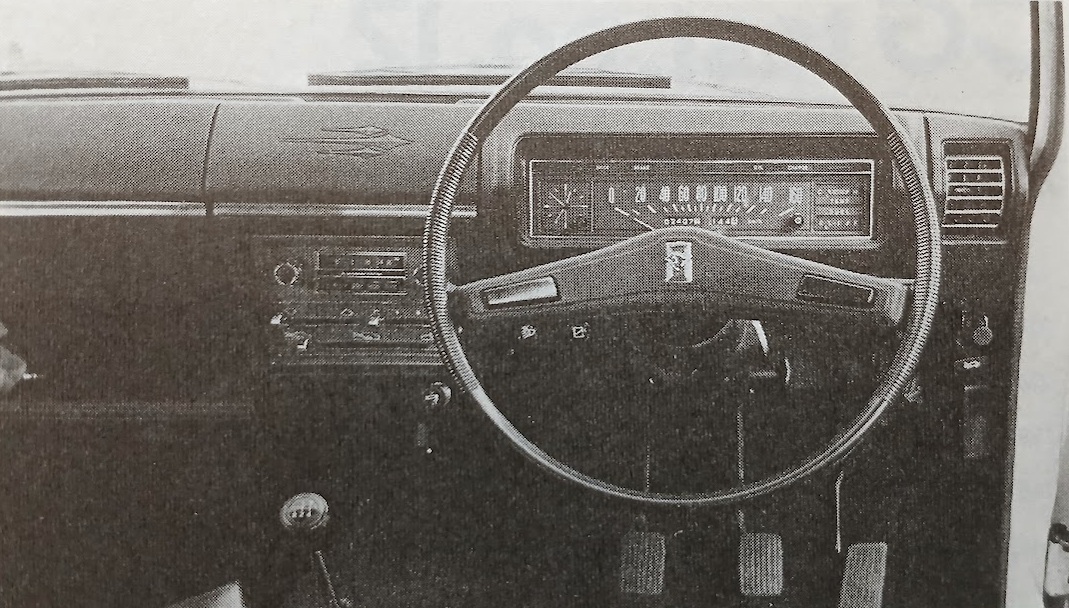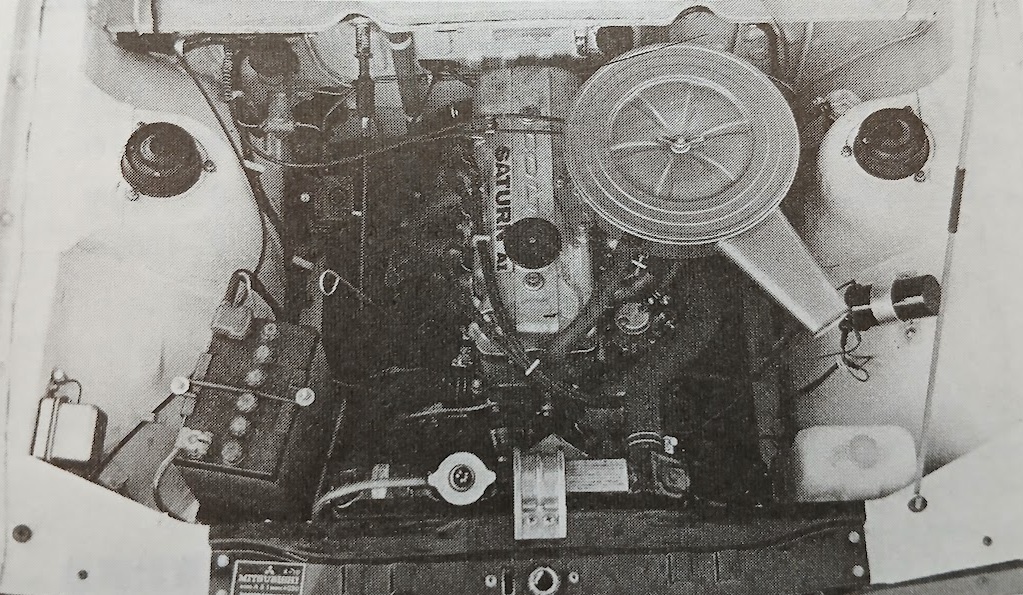Mitsubishi Colt Galant AI Custom (1970)

Publication: Car Graphic
Format: Road Test
Date: March 1970
Author: “C/G Test Group” (uncredited)
Summary: Very easy-to-drive five-seater sedan. Outstanding performance in its class, very smooth and well-balanced powertrain, slightly low-geared, generally quiet, exhaust system resonance increases at medium speeds, drum brakes prone to fade if used frequently, very comfortable.
Road testing the Mitsubishi Colt Galant AI Custom
The 1289cc Galant AI comes in four variations: the lowest-priced Standard (518,000 yen), the Deluxe (568,000 yen), the Custom (596,000 yen) with heat-absorbing glass and reclining seats, and the Sports (636,000 yen) with disc brakes in the front, wood-rimmed steering wheel, and round gauges. The car we tested this time was the Custom purchased by C/G for long-term testing, which had only been driven about 2,000km at the time of this writing. In other words, it was still a brand-new car. We were reluctant to bring a car that was not yet fully run-in to Yatabe and conduct top-speed testing (we often have to make such unreasonable demands to meet the tight schedule of the magazine), but to our surprise, this AI not only withstood the testing without complaint, but also proved that the performance data claimed by the manufacturer is not at all exaggerated. That is, the maximum speed measured over a 1km straight section was 147.0km/h (145km/h in the catalog), and the 0-400m acceleration was 18.6 seconds (18.3 seconds in the catalog), which is an outstanding dynamic performance for a pure family sedan in the 1300cc class.
The SOHC 1289cc (73mm x 77mm, long stroke) engine has a compression ratio of 9.0 and a single two-barrel Stromberg carburetor, producing an eye-opening 87ps at 6300rpm. The secret to the AI’s excellent dynamic performance is its good aerodynamic characteristics and favorable power-to-weight ratio (9.5kg/ps, compared to the Bluebird 1300’s 12.5kg/ps). The Galant engine’s smoothness and ability to rev well up to high revolutions were detailed in the AII GS report, but this single-carburetor AI is almost as good. However, while the AII GS could easily rev over 7000rpm, the AI’s intake system suddenly becomes less efficient around 6800rpm, and the revolutions hit a plateau. However, due to its extremely flexible power characteristics, there is no need to take the rotation speed above 4000rpm in any gear during everyday driving. It is amazing how well the response holds up at low speeds, and even in top gear at 30km/h (1300rpm), it accelerates smoothly and without any sign of knocking. Moreover, since it uses regular gasoline, it shows how high the mechanical octane number of the engine is.
The AI Custom is available with two transmissions, a 3-speed column shift and a 4-speed floor shift, and the C/G AI is of course the latter. The easy shifting makes it tempting to use the gear lever frequently, but there is no real need to do so due to the power. We haven’t had a chance to test the 3-speed column shift model yet, but if you are not particularly interested in fast driving, we think you will be able to get by with three speeds.
The AI has a shorter final drive ratio of 4.22 compared to the 1.5-liter AII’s 3.89, and the speed per 1000rpm in top gear is 24.0km/h, compared to the AII’s 27.1km/h. The excellent acceleration and flexibility in the low speed range are also due in part to this low gearing. In our opinion, the gear ratio of the AI is actually a little too short for the power of this model. It makes driving in the city especially easy, but when you try to go fast by winding it out in each gear, the engine is a little busy and so is the noise level. Mechanical noise is always low, but more noticeable is the resonance of the exhaust system, which becomes relatively loud at 3500rpm. This corresponds to 45-50km/h in second gear and 60-70km/h in third gear, so it is right in these practical ranges that the exhaust resonance fills the cabin. On flat roads, it is possible to start smoothly even in second gear, so even if the final drive ratio was made taller, it would not be difficult to use.
As we wrote in the report on the AII GS, the data from the constant-speed fuel economy test showed the strange result that the 1.5-liter AII GS was more economical than the 1.3-liter AI. This is not only because the C/G AI had not been fully broken in, but also because the gearing is lower across the board than the AII. The load conditions and weather conditions were exactly the same. In addition, the AII’s average practical fuel economy was 9.2km/l over the test distance of 440km, with the same driving patterns as the AI, but the total average for the AI over the 2,500km since we purchased it is 8.4km/l. The AII’s figures included a constant-speed test of about 200km on the Yatabe test course, while the AI was mostly stop-and-go driving in the city. The Galant AI is economical overall, but it would be improved if the final gear were raised slightly.
As already mentioned, the greatest strength of the Galant is that it is extremely easy to drive, and anyone can drive it with confidence from the first time they take the wheel, as if it were a car they were already used to. One reason for this is the excellent visibility from the driver’s seat, and another is the light yet predictable controls. The steering wheel takes about 3.3 turns from lock to lock, and the turning radius is only 4.6m, which is particularly convenient in crowded urban areas. The hood slopes down at the front, so you can see directly in front of the car, and the front and rear overhangs are short, so there are few cars that are easier for beginners to park.
Directional stability at high speeds is also excellent. The steering has a variable ratio, feels sharp when going straight, and has just the right amount of weight, so it’s easy to maintain a relaxed course at high speeds. The steering characteristics are appropriate for a family car, with predictable understeer. When driving fast along a winding road, keeping pace with the AII GS, I did feel that there was too much understeer, but framed purely as a family car (and with a rigid axle, at that), the Galant’s handling is above average. Despite its soft suspension, there is little change in posture when cornering, accelerating, or decelerating, giving passengers a more relaxed ride. The test car was fitted with Yokohama 6.15S-13 tires.
In the AI series of Galants, only the Sport model has disc brakes in front, while the others have self-adjusting drums on both the front and rear wheels. The pedal force is light and braking force is reliable even at high speeds, so there are no problems in everyday driving. However, when we drove hard on mountain roads in a rally style, the brakes gradually faded, and we lost confidence in our ability to maintain high speed until just before corner entries. Also, in the 0-100-0 fade test, the pedal force, which was 24kg on the first stop, increased to 36kg by the fifth stop, showing early signs of fading, and by the tenth stop, they required almost twice as much force, 47kg, showing a case of complete fade. This is the limitation of drum brakes.
The ride is comfortable on all road surfaces, considering the conventional suspension layout, and its tuning is close to ideal for a family car. It is soft, but even when going over wavy roads at high speeds, it doesn’t bounce, and the suspension absorbs irregularities well and doesn’t transmit them to the body. Road noise is also well muted, and we imagine it would remain acceptable even with radial tires. The car rides a bit low for tackling truly bad roads, however (fortunately, these are less common around Tokyo), and we once scraped the oil pan even though we weren’t going very fast.
One of the attractions of the Galant is the interior, which is of exceptional quality and finish for a low-priced car. The individual front seats have to be slid all the way back for a tall driver, but even in that case, there is still a reasonable amount of legroom in the rear seats. The urethane foam cushions are moderately soft and have a firm base, making them some of the best among Japanese cars. The rear seat cushions are low to the floor and therefore the backrests are tall. The rear seats are also extremely comfortable, allowing five adults to ride comfortably.
Another good feature of the Galant is its heater and ventilator system. Not only can you choose between fresh or recirculated air, but the fresh air vents on either side of the dash can also blow out heated air using the booster fan (which has three speeds and is quiet). The engine warms up quickly, so the heater starts working after just five minutes of driving. The ventilator is also effective. Two people tried smoking a cigarette while driving at 50km/h, and the smoke did not linger in the cabin, but was sucked out through the outlets behind the rear seats (no blower was used, just the airflow). However, because this air vent is designed to connect directly to the outside (without passing through the trunk, etc.), the noise from passing cars, and the sound of people standing and talking directly behind the Galant while parked, can be heard surprisingly loudly inside the cabin.
The only storage space inside the car is a large glovebox on the dash (big enough to fit a handbag) and a shelf underneath (the edge is so low that things slide off when accelerating). We’d like to see a storage compartment in the console like in the AII GS and AI Sport.
The trunk is long but relatively shallow, and the opening is rather narrow. The trunk lid itself also serves as a radio antenna, so you can forget about the antenna’s existence altogether.
The Galant’s body is solidly constructed, and there was no abnormal vibration or creaking, even on rough roads. Despite the lightweight body, the doors close with an “expensive” sound.
Postscript: Story Photos




